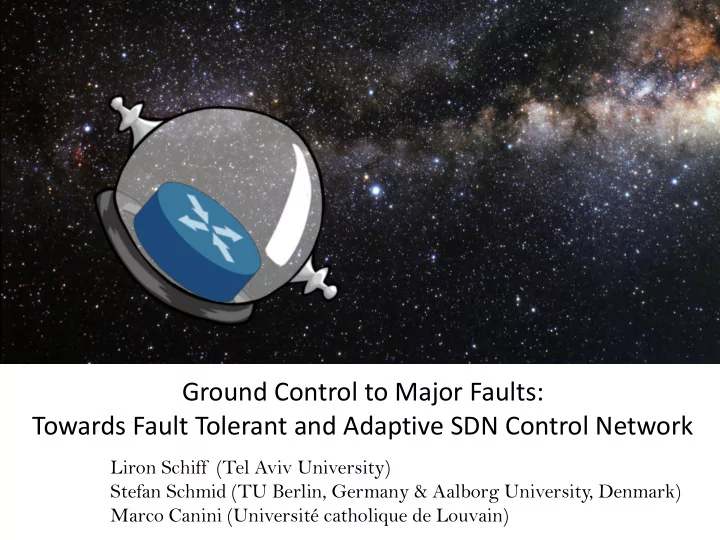

Ground Control to Major Faults: Towards Fault Tolerant and Adaptive SDN Control Network Liron Schiff (Tel Aviv University) Stefan Schmid (TU Berlin, Germany & Aalborg University, Denmark) Marco Canini (Université catholique de Louvain)
Software Defined Network (SDN) Logically centralized control Control plane network Fast data plane
SDN control-plane • Main function: – Connect the controller with each switch Controller
SDN control-plane • Main function: – Connect the controller with each switch • Can be distributed – Handle failures – Load balancing – Need synchronization
SDN control-plane • Main functions: – Connect the controller with each switch – Inter-connect the controllers • Can be distributed – Handle failures – Load balancing – Need synchronization
SDN control-plane • Main function: – Connect the controller with each switch – Inter-connect the controllers • Can be distributed – Handle failures – Load balancing – Need synchronization • Can be in-band – Cheaper – More provisioned (redundancy) – More flexible (TE, unicast, etc.)
Switch Structure (Model) • Control traffic is sent in- band. Control • The switch identifies and Module forward it to the control module. • Supported by OpenFlow. In-band processing
Challenge: Boot Up • Switches start as unmanaged. • Switches should be configured to forward control in- band.
Challenge: Boot Up • Switches start as unmanaged. • Switches should be configured to forward control in- band.
Challenge: Plug&Play • Support new links / switches / controllers • Switches can’t be configured with all possible controllers.
Challenge: Plug&Play • Support new links / switches / controllers • Switches can’t be configured with all possible controllers.
Challenge: Handle Failures
Challenge: Handle Failures • Goal: Network should return to a good state .
Model “Good network state” := • Every switch is connected to a controller. • Controllers can communicate and make joint decisions.
Our Contributions A Plug & Play Distributed SDN Control Plane • Flexible controller membership (additions, removals, failures) • Automatic switch discovery & topology awareness • Supports ONIX, ElastiCon, Beehive, STN, and more. Self Adjusting • Converges to “good state” from unmanaged states. • Tolerates failures and delays: low re-convergence times
The Medieval Scheme • Controllers aim to continuously grow their management regions... • … and “conquer” unmanaged switches. • Management with two spanning tree types: (1) Per-region spanning tree (bidirectional, owned by controller) (2) Network-wide spanning tree (to connect controllers)
Switch States 1 1 2 2 x Managed Unmanaged Session 1. Controller traffic 1. Broadcast established is passed through 2. Any controller 2. Other controllers can respond are blocked No keep-alive timeout
Switch State Configurations A priori configured Rules Properties Managed Priority 2, with timeout Unmanaged Priority 1, no timeout Maintained by controller
The Protocol Controller uses a managed switch, R, to detect and establish connection to a new switch S.
The Medieval Scheme • Controllers aim to continuously grow their management regions... • … and “conquer” unmanaged switches. • Management with two spanning tree types: (1) Per-region spanning tree (bidirectional, owned by controller) (2) Network-wide spanning tree (to connect controllers)
The Medieval Scheme • Controllers aim to continuously grow their management regions... • … and “conquer” unmanaged switches. • Management with two spanning tree types: (1) Per-region spanning tree (bidirectional, owned by controller)
Controller to Switch Connectivity Switch S1 S7 Controller S3 S5 A B Spanning Tree Link ARP S4 S6 Other Link S2 S8 ARP Anchor switch Unmanned switch pkt-in(ARP) Controllers “conquer” switches adjacent to their regions of control and build a spanning tree for controller-to-switch connectivity.
The Medieval Scheme • Controllers aim to continuously grow their management regions... • … and “conquer” unmanaged switches. • Management with two spanning tree types: (1) Per-region spanning tree (bidirectional, owned by controller) (2) Network-wide spanning tree (to connect controllers)
Controller to Controller Connectivity S1 S7 S3 S5 A B S4 S6 S2 S8 Per-controller global spanning trees provide controller-to-controller connectivity.
Prototype Implementation - Emulator in Java - OpenFlow switches and controllers: light- weight threads - Links modelled by message queues - Fat-tree topology (k=4), 1-8 controllers - Measured time to manage switches # ctrls 1 2 3 4 5 6 7 8 Time (ms) 9382 6983 6150 4224 6035 5104 3704 3680
Prototype Implementation
Conclusions • Medieval: a robust distributed SDN control plane. • Fully supported by OpenFlow. • Convergence can be proved and easily tested. • Extended analysis and simulation are coming soon.
Recommend
More recommend